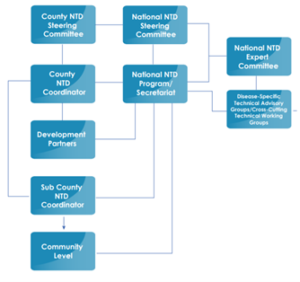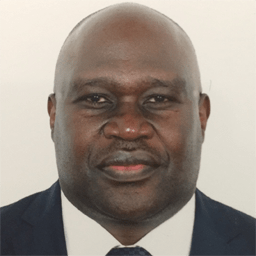An Eye to 2030: Making NTD Gains in Kenya Through WASH
March 30, 2021
Written by Stephen Hilton, Global Water 2020 on behalf of the NTD NGO Network’s Water, Sanitation and Hygiene Working Group
On World Water Day 2021 (March 22), the World Health Organization officially released its 2021-2030 Global Strategy on Water, Sanitation and Hygiene (WASH) to Combat Neglected Tropical Diseases (NTDs). The Global Strategy is one of several official companion documents to the 2021-2030 NTD road map, which launched in January for World NTD Day 2021 and included, for the first-time, a cross-cutting indicator for WASH that countries must meet by 2030; that is: universal WASH access in all NTD endemic areas.
Today, WHO is celebrating the launch through an online event to catalyse new partnerships and inspire commitments across the WASH and NTD sectors, in terms of funding, policymaking and joint programming. The event features global, regional and national perspectives around successful WASH and NTD collaboration with an eye to 2030, including from Kenya where the Ministry of Health has been a true leader for this important, life-sustaining work.
To mark the launch of the Strategy, Global Water 2020’s Stephen Hilton, on behalf of the NTD NGO Network’s (NNN) WASH Working Group, caught up with Dr. Sultani Hadley Matendechero, Director of Kenya’s Division of Vector Borne and Neglected Tropical Diseases at the Ministry of Health. His department coordinates multi-sectoral programming to control and eliminate NTDs, such as soil-transmitted helminthiasis, schistosomiasis, lymphatic filariasis, and trachoma—diseases that remain prevalent throughout Kenya. Dr. Matendechero, who is a pharmacist by profession, has been a strong advocate for providing access to safe WASH services, which is essential for the control, elimination and eradication of all NTDs across the continuum of prevention, treatment, care and morbidity management.
What motivates you to integrate WASH into your NTD programming at the Kenyan Ministry of Health?
SM: Over time, I have realized the importance of safe water, basic sanitation, and general hygiene in controlling and eliminating NTDs. Yes, we use pharmaceutical interventions like Mass Drug Administration (MDA), which can rapidly bring down disease prevalence to remarkably low levels. Unfortunately, I noticed that a few weeks or months later, the prevalence bounces back to the pre-MDA levels. We have demonstrated that one of the main reasons behind this loss of gains is the absence of WASH interventions. That’s why I believe that for our pharmaceutical interventions to be meaningful, we must have sufficient WASH facilities in place. If adequate WASH interventions are implemented, up to 70% of the problems with NTDs will automatically resolve.
What is an example in Kenya that demonstrates how important WASH can be for controlling NTDs?
SM: Before 2007, Kitui County was among the known trachoma-endemic areas in the country. Following the coming into power of a new government in 2007, many water projects were established in Kitui as part of the new government’s drought relief program. When we conducted a routine assessment for trachoma in 2016, we realized that trachoma had been eliminated in Kitui. It took us some time to realize that the WASH interventions which had been inadvertently put in place by the drought relief program, could have played a fundamental role in this development. This is because clean faces are incompatible with trachoma and the availability of water must have spurred behaviour change which led to more frequent face-washing within the area. Because of this elimination of trachoma in Kitui, we saved more than 300 million shillings annually, which would otherwise have been used in implementing mass treatment interventions against trachoma. Further, we estimate that the investment that was put in WASH is less than 20% of what we would have spent on MDA alone. One can only wonder what the substantial amounts of money saved can do… build several community hospitals perhaps? Invest in education programs or community youth empowerment programs? Your guess is as good as mine.
What challenges have you faced in Kenya with integrating WASH and NTDs nationally and locally?
SM: The biggest challenge is the wrong perception that the installation of WASH facilities is a very expensive exercise. However, by establishing functional and working relationships with other stakeholders, including in the WASH sector, you do not need a ton of money. Many stakeholders are resistant to change, such as embracing a paradigm shift towards closer partnerships that enhance the provision of WASH interventions for NTD control. Many WASH stakeholders may initially feel that these partnerships can only be a one-way relationship where only the NTD sector benefits. To address this, we have come up with innovative ways of ensuring that the WASH sector benefits just as much as the NTD sector. We even spell out the benefits to the WASH sector and other stakeholders in our Breaking Transmission Strategy (BTS).
What have you done to overcome challenges associated with cross-sectoral coordination?
SM: We have established a very robust government-led coordination mechanism for NTDs in our BTS, which I encourage other countries to emulate. NTDs are unique diseases that require everyone to contribute to control and elimination.
There is a National NTD Steering Committee with high-level representation, whose chairmanship is at the cabinet secretary-level. This committee ensures coordination, sustainable resource mobilization, and more. We involve multiple departments so that we can capitalize on the work they already do. We include research institutions such as the Kenya Medical Research Institute (KEMRI), the International Centre of Insect Physiology and Ecology (ICIPE), and academic institutions like the University of Nairobi. Local experts in the NTD field have been officially engaged to advise the steering committee. We also have technical advisory groups comprised of implementers and experts for specific diseases. They bring people from all sectors to deal with cross-cutting issues such as WASH and behaviour change communication, among others. This coordination mechanism ensures that we have dozens of people from all sectors at the national- and subnational-levels intimately participating in the day-to-day running of NTD control activities.

Structure for implementing the BTS, adapted from the Kenya National BTS (page 46).
What accomplishments are you most proud of?
SM: We reactivated many programs to great success. For example, after reorganizing our efforts on lymphatic filariasis in 2015, we have implemented a remarkable raft of interventions over the last six years. We are now looking forward to implementing transmission assessment surveys this year, which we expect will confirm the elimination of the disease from Kenya. This will be an enchanting addition to our list of achievements after attaining certification of Guinea worm disease eradication in Kenya only two years ago.
What role do you see the new 2021-2030 NTD Road Map, as well as accompanying Global Strategy on WASH and NTDs, playing in accelerating progress on WASH and NTDs this next decade?
SM: We adopt international guidelines, strategies, and roadmaps into many of our plans, such as the BTS. The three pillars of this plan are to increase coverage of MDA, expand WASH interventions, and mainstream behaviour change and communication activities, in addition to other interventions such as integrated vector management and effective monitoring and evaluation. This year we are going to review our national strategic plan for NTDs and we are going to borrow heavily from the NTD roadmap that has been launched by WHO. This will include expanding the WASH and behaviour change and communication pillars, which will read well when seen against the backdrop of the BTS.
What are the next steps for WASH and NTD coordination in Kenya?
SM: We have rated coordination as the most important aspect of NTD control, and are looking to improve it. We are expanding the membership of our committees with more technical experts and strengthening partnerships by involving more stakeholders in the NTD/WASH technical working group. We want to create new external partnerships and have been having meetings in the afternoon so we can involve stakeholders in America and Europe. With lymphatic filariasis out of the way, we are shifting our full attention towards trachoma elimination. This is an objective we expect to meet within the next five years at a maximum.
We’ll be ramping up the BTS. Within the next two to three years, we should be able to scale up BTS implementation to more than 30 targeted counties. We’re also beginning implementation in order to eliminate schistosomiasis and soil-transmitted helminthiasis in all areas where elimination is possible. Moving forward, we want to ensure that we don’t just pay attention to MDA, but ensure that WASH and behaviour change and communication are at the centre of our implementation as well.
